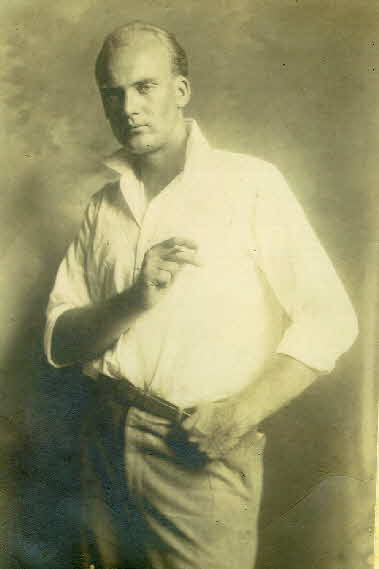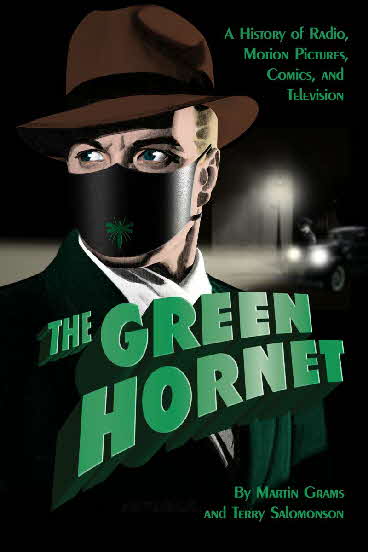|
Local writer has ties to “The Green Hornet”
While area residents join others across America going to see the latest movie version of “The Green Hornet,” many in the audience probably don’t realize that a former local resident was part of the drama’s storied past. And he created one of the more unusual stories for the program that was ever heard.
Before the movie and television versions, “The Green Hornet” visited millions of American homes through their radios as they heard Britt Reid, publisher of The Daily Sentinel, use information he learned from the police to put away the crooks in town with the help of his sidekick, Kato, and the use of his black speedster known as The Black Beauty.
It was during what many call the “Golden Age of Radio,” and people eagerly waited each week to hear the adventures featured on favorite programs such as “The Lone Ranger,” “The Shadow,” and “The Green Hornet.”
One of the people who brought those stories to life was Stryker native Ralph Goll, pictured here. Goll, who later lived in the Nettle Lake and Montpelier areas, is credited with writing an armful of stories for the famous “Lone Ranger” radio program.
Terry Salomonson of Audio Classics Archives in Howell, Mich., is a highly-regarded expert on the programs that were broadcast during the Golden Age of Radio. He has copies of original scripts of many of the programs and painstakingly transcribes disc recordings of the original programs to CDs so that the programs may be saved in the best audio condition possible for future generations.
Mr. Salomonson traced the first story written for “The Lone Ranger” by Mr. Goll to an episode that aired April 25, 1947. In all, Mr. Salomonson documented at least 82 “Lone Ranger” program scripts written by Goll through 1952. Later, some of those scripts were adapted as screenplays for the popular “Lone Ranger” television series.
But it appears before Mr. Goll began writing stories for “The Lone Ranger,” he was writing for “The Green Hornet.” A newspaper clipping from the April 21, 1947, Montpelier Leader Enterprise, announcing the broadcast of “The Lone Ranger” story written by Mr. Goll proclaims, “Ralph has also been responsible for some of the chills and thrills emanating from ‘The Green Hornet’ program.”
Mr. Salomonson along with Martin Grams has recently written a definitive history of the famous program, “The Green Hornet, A History of Radio, Motion Pictures, Comics, and Television.” (The stylish cover to the book is shown below). Included with fascinating background tales about the program is a complete log of the episodes of “The Green Hornet.”
In it, the pair documented a program written by Ralph Goll that was broadcast before any of his scripts for the masked lawman. The story is called “Fire Blitz” and aired November 21, 1943.
In fact, the credits actually indicate that the script was a rewrite of an original Ralph Goll script done by Dan Beattie, one of the group of drama scriptwriters for shows like “The Lone Ranger” and “The Green Hornet.”
Why there was a need for a rewrite of Goll’s script or what exactly happened to the original script, Mr. Salomonson does not know.
But what he does know is that he feels it was one of the most interesting stories ever written for “The Green Hornet.”
Many of the stories involving the Green Hornet were about his crime-fighting efforts against neighborhood crime or corruption at city hall, Mr. Salomonson said. “It was Jimmy Cagney kind of crime,” he said.
But the “Fire Blitz” story is about fighting Nazis during World War II, which brought a whole new dimension to the program. The story not only brought a fascinating new twist to the series, but Mr. Salomonson pointed out that he noticed a much stronger quality shown in the writing.
He said the story begins with Joe Doakes, aka Three Fingers O’Malley, who arranges the hijacking of a truck carrying a load of wastepaper and the murder of its driver. Dr. Von Alt, a German scientist, uses the stolen paper and a time bomb to start a forest fire in the northern part of the state, destroying vast and valuable timberlands on which the nation depends for materials vital to the war effort.
When Gail Manning, a Sentinel reporter (and a character that surfaces several more times in the program), gets too close to the scheme, she finds herself a prisoner of the German spy.
The Green Hornet discovers where Gail is being held captive. As he enters the room, he sees she has fainted. The scientist takes a shot at him and starts a fire in the room hoping it will be the end of the two.
As you might suspect, the Green Hornet prevails, releasing Gail in the nick of time. Having led the police to the site, he sets the stage for them to capture the spy ring and procure the evidence they need to prosecute the ring, just as he makes a clean escape from them so he can continue his crime-fighting ways.
Not only is the story unique for the series, it is also a rare one. While some of the broadcasts have been publicly re-leased, “Fire Blitz” remained uncirculated from the time of its original broadcast until a couple of years ago when Mr. Salomonson played it for an old-time radio convention. It has not yet been released for sale to the general public.
Are there other stories for the series written by Goll? “I don’t know if he wrote more than that,” Mr. Salomonson says. “There’s a possibility.”
Salomonson has 1,041 scripts from the program, spending days in the Library of Congress trying to track down all of them that exist. But there are still a couple of scripts that elude him, so he will continue to search to see if the final missing documents turn up and if they bear the name of Ralph Goll as the writer.
Those who would enjoy learning more about “The Green Hornet,” can obtain copies of the book or other old-time radio shows and information from Mr. Salomonson by contacting Audio Classics Archives at www.audio-classics.com.
In the meantime, the search will go on for the missing scripts to see if they could also be written by the Stryker native who knew how to write a story designed to keep listeners on the edge of their seats.
|

